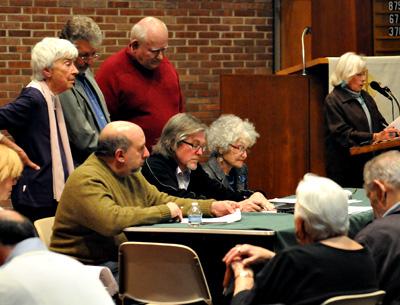New Helicopter Routes Endorsed
New Helicopter Routes Endorsed

A plan devised by a task force to “spread the pain” of helicopter noise over three routes into and out of East Hampton Airport was supported by a majority of the East Hampton Town Board on Tuesday, although officials acknowledged it would make no one happy.
A switch last year in the predominant helicopter route, sending most of the craft over Jessup’s Neck in Noyac as well as over hundreds of Noyac and Sag Harbor houses, caused residents there, and their elected officials — Southampton Town Supervisor Anna Throne-Holst, Representative Tim Bishop, and New York State Assemblyman Fred W. Thiele Jr. — to descend on the East Hampton Town Board asking for a change before this year’s busy season.
The task force was made up of representatives of several civic groups, regional airports, and the Towns of Southampton, Shelter Island, and Southold. The plan it came up with was outlined for the town board at a work session on Tuesday by Jim Brundige, the East Hampton Airport manager. Though the town has no authority to require aircraft to use particular routes, protocols are usually discussed and agreed upon with industry representatives, and, said Mr. Brundige, compliance with suggested routing is good. He is now expected to work with a helicopter pilots’ association to put the new guidelines in place.
The new protocol limits the flights over the Jessup’s Neck area, which intersects with a “waypoint” where helicopters turn off an F.A.A.-mandated east-west route along the north shore of Long Island. That route is now to be used only by incoming aircraft.
Half the departing helicopters will be sent on a new route over Barcelona Neck in East Hampton, “with the intention” that helicopters be at least 3,000 feet above ground by that point, Mr. Brundige said, though conditions and individual helicopter performance may vary. Other outgoing helicopters, as well as a percentage of incoming craft, will be asked to use a route along the south shore, accessing the airport over Georgica.
“The issue over the last few years was the inequity that we threw this over a neighboring town,” Town Supervisor Bill Wilkinson said at the meeting.
Southampton Supervisor Throne-Holst attended the session, representing, she said, not only her constituents but Southampton Councilwoman Christine Scalera, Mr. Thiele, and Mr. Bishop. She expressed concern that East Hampton might not implement the routes proposed by the task force, but she called the effort by East Hampton to distribute aircraft noise more widely “the right and courageous thing to do.”
“We had a very clear understanding that what we worked on there, we were committed to,” Ms. Throne-Holst said, “. . . that what we came up with there was the protocol for the 2013 season.”
“Perfect — no. Better? Most certainly,” she said. “So here we are, the Tuesday before Memorial Day weekend, and I have to say that I bring collective concern from Congressman Bishop, Assemblyman Thiele, and my constituents that that is not what is going to happen.”
The majority East Hampton Town Board consensus served to alleviate that concern. But even with the new routes, Ms. Throne-Holst said, “No one will be completely happy. It’s a problem that essentially doesn’t have a solution, as long as there’s an airport. I understand the conundrum; most citizens will understand the conundrum — some won’t, many will.”
“The board has an obligation to ensure that we’re not unfairly burdening one group,” East Hampton Councilwoman Theresa Quigley said.
However, Councilman Peter Van Scoyoc said that given his primary responsibility to represent East Hampton constituents, “I cannot recommend additional routes.” In addition, he said, “I am extremely disappointed that we are establishing what amounts to a helicopter superhighway over our most protected and pristine parts of town. We are going to greatly diminish the experience of visitors there,” he said.
“If we’re going to share the pain, let’s spread it even more widely,” he said, suggesting a 360-degree spectrum of routes. That, Mr. Brundige said, would be impractical to implement, though not impossible.
“Route changes do not address the problem,” Mr. Van Scoyoc continued. “I think that the whole discussion of routes really takes the focus off dealing with the real problem. Rerouting traffic doesn’t alleviate the problem; it only displaces the burden. Unless you pursue restrictions that you limit the number of impacts, or reduce the number of impacts. . . . We have no legal control unless we have control over our airport,” he said.
The acceptance of F.A.A. grants leaves the town tied to the agency’s operational guidelines for the airport. Whether the town could, or should, eschew further grants, and how the town might position itself to gain greater autonomy over airport operating decisions, such as potentially limiting its use or the hours of operation, has been a subject of contentious debate. Existing “assurances,” or agreements, with the F.A.A., will expire after 2014, and the town has begun to gather aircraft noise data that could be used to make a case for local control.
The key focus, Councilwoman Sylvia Overby agreed, should be “on the end of 2014, and getting rid of the F.A.A. assurances. . . . “I’m very conflicted,” she said, as far as interim decisions about what to do for this summer season and next, noting that the board will inevitably hear from East Hampton residents under the proposed new helicopter routes. But, she said, “I believe in being a good neighbor, and would expect the same from Southampton.”
She endorsed the suggested new routes reluctantly, as did Councilman Dominick Stanzione. “I’m very reluctantly going to not oppose what Jim’s proposing,” Mr. Stanzione said.
“Let everyone get disturbed, and let everyone come to this town board and say, ‘this is not the quality of life’ ,” Ms. Overby said.
“How many lines do you have for noise complaints?” she asked Mr. Brundige rhetorically. “Just one? Tongue-in-cheek, I’m suggesting you increase it.”

